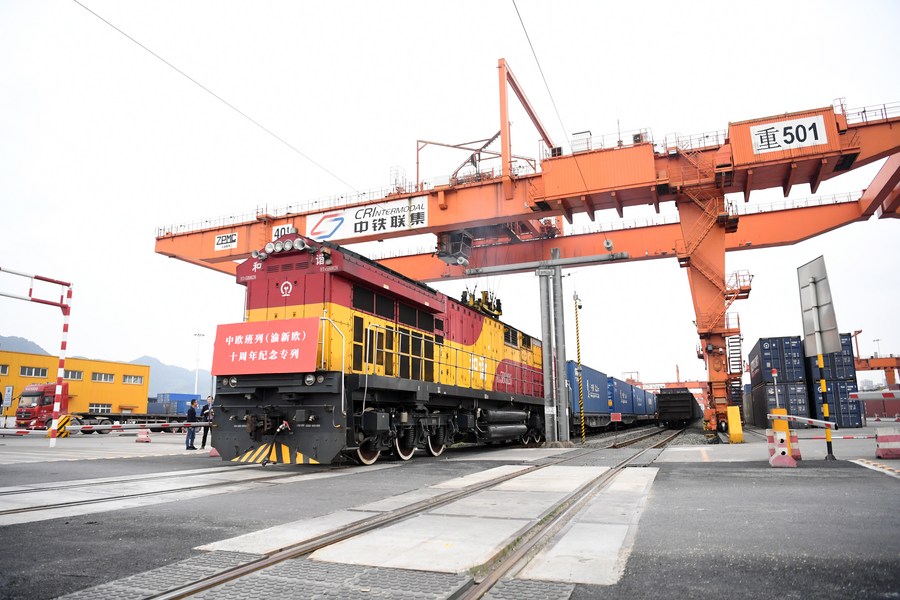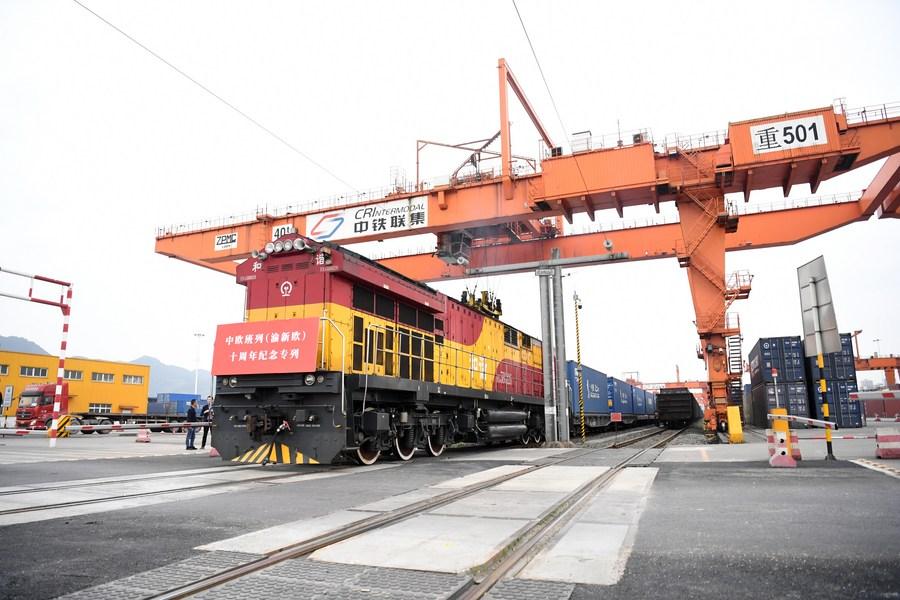
A Yuxin'ou (Chongqing-Xinjiang-Europe) China-Europe freight train is about to leave the Tuanjie Village Station of southwest China's Chongqing Municipality, March 19, 2021. (Xinhua/Tang Yi)
BEIJING, April 14 (Xinhua) -- The third batch of China's pilot free trade zones (FTZs), inaugurated in April 2017 and respectively located in Liaoning, Zhejiang, Henan, Hubei, Sichuan and Shaanxi provinces and Chongqing Municipality, have recently made public the five-year development results in succession.
The results, especially those in imports and exports and foreign investment utilization, have shown that these FTZs have become important windows for the opening-up of China.
-- Remarkable development results
Liaoning FTZ
In the past five years, the Dalian Area of Liaoning FTZ has seen imports and exports total 722.2 billion yuan, registering an average annual growth rate of 8 percent, with the actual use of foreign investment recording 4.96 billion U.S. dollars.
A total of 41,000 domestic enterprises have newly settled in the area, 5.5 times the number before the approval of the area. The number of new foreign-funded enterprises was 1,200, 2.83 times that before the approval.
The Shenyang Area of Liaoning FTZ has seen 132 newly-settled national high-tech enterprises in 2021, ranking the second in the city in terms of the increment, and totaling the number of high-tech enterprises to 314 which is 24 times that in the early days of the establishment of the FTZ.
In 2021 alone, the imports and exports of the Shenyang Area reached 12.92 billion yuan, up 187.1 percent year on year.
Over the past five years, the Yingkou Area of Liaoning FTZ has strengthened the construction of open platforms like the Yingkou Comprehensive Bonded Zone, the central business district, and the international mail (express) center with 1.6 billion yuan of investment.
Up to now, there are 425 registered enterprises in the Yingkou Comprehensive Bonded Zone, among which 207 are registered with the customs. In 2021, the total imports and exports of the zone registered 3.97 billion yuan.
Zhejiang FTZ
As the achievements of reform have been continuously implemented, Zhejiang FTZ has become an important driving force for stabilizing foreign trade and foreign investment.
By the end of 2021, the total imports and exports trade in the zone reached 1.4 trillion yuan, with the figure in 2021 exceeding 770 billion yuan. The total amount of foreign investment in actual use in the zone reached 4.2 billion U.S. dollars, with the figure in 2021 exceeding 2.5 billion U.S. dollars.
In 2021, Zhejiang FTZ has contributed 7.6 percent of the newly registered enterprises, 8.1 percent of the tax revenue, 18.6 percent of the imports and exports and 13.8 percent of the foreign capital in actual use in the whole Zhejiang Province.
By February this year, the total number of enterprises in the zone has increased by 93,000.
Henan FTZ
In the past five years, 118,000 enterprises have been set up in Henan FTZ, 4.4 times the number before it was inaugurated, effectively stimulating the vitality of market players, and by the end of 2021, 125 Fortune Global 500 enterprises and 100 top 500 domestic enterprises had invested in the zone, according to Wang Zhenli, head of the Department of Commerce of Henan Province.
During these years, the foreign trade of Henan FTZ has grown rapidly, with the imports and exports recording 58.03 billion yuan in 2021, up 144.8 percent year on year.
The Zhengzhou Area of Henan FTZ has made outstanding achievements in international freight routes and cross-border e-commerce. In the past five years, the cargo throughput of the Zhengzhou Xinzheng International Airport has increased by 54.3 percent; the trips made by the Zhengzhou China-Europe freight trains have increased by five times; the cross-border e-commerce transaction has increased by nearly three times; and 115 Fortune Global 500 enterprises and 90 top 500 domestic enterprises have settled here.
The Kaifeng Area focuses on "art trading" and "cultural finance". In July 2020, it established the first art bonded warehouse in central China, and the total imports and exports of the warehouse have exceeded 600 million yuan since its opening.
The Luoyang Area focuses on intelligent equipment, and has built industrial clusters in fields like robotics, photoelectric components and new energy materials. Over the years, the total foreign investment in use and the imports and exports of the area registered 2.304 billion U.S. dollars and 25.778 billion yuan, 5.5 times and 17.8 times respectively that before its inauguration.
Hubei FTZ
In the past five years, Hubei FTZ has seen a total of 83,000 newly-settled enterprises, three times the original stock of enterprises before its inauguration. With less than 7/10,000 of the province's land area, the FTZ has generated 30 percent of the foreign trade, 13 percent of the foreign investment and 18 percent of the number of high-tech enterprises in the whole Hubei Province over the same period.
Chongqing FTZ
Data from the Chongqing Municipal Commission of Commerce showed that over the past five years, Chongqing FTZ has seen more than 65,000 newly-added market players in total.
The newly-established foreign-funded enterprises in Chongqing FTZ accounted for 20 percent of the total throughout Chongqing, introduced Li Xunfu, deputy director of the Chongqing Municipal Commission of Commerce, adding that the FTZ has attracted more than 35 percent of the city's foreign direct investment (FDI), gathered more than 1/4 of the city's import and export enterprises, and contributed about 70 percent of the city's total import and export trade.
Sichuan FTZ
After five years of development, Sichuan FTZ has become a hub for opening-up. Data showed that by December 2021, the Sichuan FTZ had seen 192,000 newly-established enterprises with the registered capital exceeding 1.9 trillion yuan, introduced 494 projects each worth more than 100 million yuan with 3.2 billion U.S. dollars of foreign investment actually in place, and realized imports and exports of 351.58 billion yuan.
Facing the challenges posed by the COVID-19 pandemic, Sichuan FTZ has shown greater resilience and vitality. In 2021, the zone has seen 55,635 newly-established businesses, an increase of 24 percent over 2020, as well as FDI of 1.51 billion U.S. dollars, up 69.7 percent over 2020.
Shaanxi FTZ
From its opening on April 1, 2017 to the end of March 2022, Shaanxi FTZ has seen a total of 112,479 newly-settled market players, with a newly-registered capital of 1,075.489 billion yuan, including 73,795 newly-established enterprises with 786 foreign-funded ones.
The trips made by the Chang'an China-Europe freight trains have increased from more than 100 in 2017 to 3,841 in 2021.
In 2021, the total goods imports and exports of Shaanxi FTZ registered 337.53 billion yuan, accounting for 70.9 percent of the province's total, and recording a year-on-year growth of 25.8 percent.
From January to February in 2022, the total goods imports and exports of the FTZ reached 54.18 billion yuan, up 30.9 percent year on year and accounting for 71.39 percent of the province's total.
The FTZ has also set up 17 offshore innovation centers and R&D centers in the United States, Israel and other countries, and formed a silk road university alliance with 151 universities from 38 countries and regions.
-- Important windows for high-level opening-up
The FTZs have become windows of opening-up, playing a demonstrative and leading role in facilitating trade and investment, promoting the reform of streamlining administration and delegating power, improving regulation and upgrading services, focusing on open development of advantageous industrial chains, and serving major national strategies, and contributing to stabilizing the foundation of foreign trade and investment, said Liu Xiangdong, deputy head of an economic research arm with the China Center for International Economic Exchanges.
Data from the Ministry of Commerce showed that in 2021, the foreign investment utilized by the 21 FTZs in China grew by 19 percent, 4.1 percentage points higher than the national level, and the imports and exports increased by 29.5 percent, 8.1 percentage points higher than the national level.
The above-mentioned seven FTZs should actively play the experimental role, as well as the demonstrative and leading role in regional economic development and the development of strategic emerging industries, and meanwhile make further progress in institutional innovation, noted Xiao Benhua, deputy head of the FTZ research institute with the Shanghai Lixin University of Accounting and Finance.
Efforts should also be made to optimize the business environment, constantly cultivate new economic growth points, and promote the replication of institutional innovation results, so as to accumulate experience for future openness in broader areas, said Liu Xiangdong.
(Edited by Gu Shanshan with Xinhua Silk Road, gushanshan.1987@163.com)




 A single purchase
A single purchase









